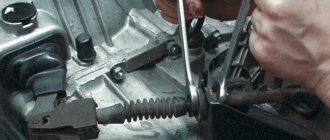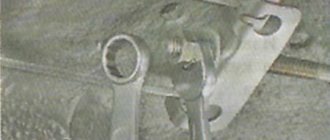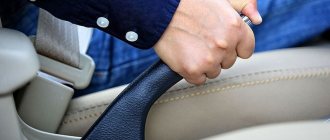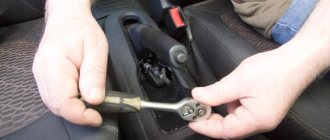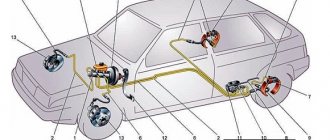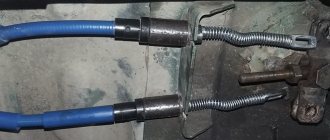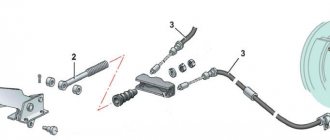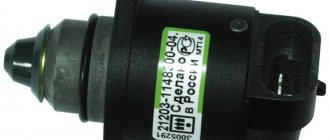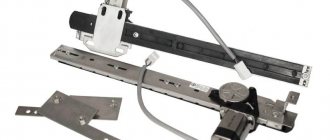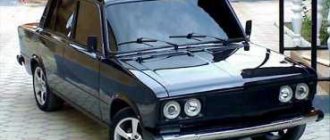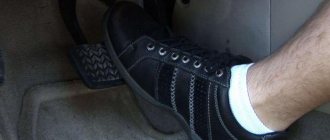Not all motorists use the handbrake, especially in winter, when the brake pads may ice up. In this case, the handbrake begins to jam. But according to traffic rules, you need to use the parking brake for safety reasons. At the same time, the braking system itself must be in good condition. Although sometimes it happens that the handbrake does not hold when turned on. Why this happens and how to fix the problem - all this will be discussed in this article.
Why won't the handbrake hold?
Hand brake device
The principle of operation of the parking brake is quite simple. There is a handle inside the car, to which a special durable braided cable is attached. It is in this braid that the cable runs when the handbrake is turned on. The cable is connected to a bar, from which more cables run on both sides to the rear wheels. There are special brackets at the edges of these cables, which open the brake pads if necessary, thereby blocking the car's wheels.
Parking brake device
If we describe the design of the handbrake in simple words, then when the handle is lifted, the cable in its braid is tensioned and, consequently, the brackets responsible for spreading the rear brake pads are released. The more the handbrake is raised, the more the brake wheels will be spread apart.
Hydraulics or mechanics
It is worth noting that at the moment not all rear brakes are cable or mechanical; now there are quite a large number of handbrake brakes that operate hydraulically, this is especially true for rear disc brakes rather than drum brakes . Hydraulics duplicate the operation of the main braking system.
That is, when you lift the handle, a special piston creates pressure on the rear discs and they are blocked. If the handbrake does not work in such a system, then the reasons are significantly different from its mechanical counterpart.
Characteristic signs of failure
Even a novice can identify a faulty parking brake. As a rule, the following signs indicate this:
- the vehicle is not secured securely after applying the handbrake, the wheels do not lock;
- it takes a lot of effort to lift the handle;
- the unit moves quite easily, no resistance is felt.
Signs of a faulty handbrake
If at least one of the above symptoms appears, you need to check the serviceability of the parking brake. If the unit does not work, it is important to understand why the handbrake does not hold.
Causes and solutions
As practice shows, most often the handbrake does not hold for trivial reasons that can be easily corrected. For example, the unit stops functioning normally due to oil getting on the friction material of the brake pads, improper adjustment, jamming or damage to the cable, etc. Now let's talk more about the main reasons.
Causes of parking brake failure
Oil getting on the pads
Even a small amount of oil on the brake pads can cause the parking brake to perform poorly. It is important to identify the cause of the fluid leak. As a rule, this occurs due to damage to the oil seal or brake cylinder. It is necessary to eliminate the leak and clean the surface of the parts.
Oil on brake pads
Note! If the brake pads are very oily, cleaning will not help. They need to be completely replaced.
Brake pad wear
As your vehicle operates, brake pads gradually wear out. If you do not take care of this and do not carry out regular maintenance, then eventually the braking system will not work properly, since most of the friction material on the pads has been worn away. The solution is simple - you need to buy a set of new pads and replace them.
Brake pads are worn out
Incorrect adjustment
Often the parking brake does not work due to an incorrectly adjusted cable system. For example, the length of the cables was chosen incorrectly or errors were made when adjusting the system. In this case, the cables must be tensioned correctly and in accordance with the instructions.
Misaligned handbrake cable system
Dirt on the surface of the pads
Oil is not the only thing that can disrupt the brake system when it gets on the pads. The malfunction may be caused by ice, dirt or dust from the road. Also, reagents used in big cities for sprinkling roads in winter can get on the pads. In this case, it is enough to simply press the brake pedal several times smoothly. When friction occurs, the surface will be cleared of accumulated dirt, and the handbrake will begin to function normally.
Contaminated brake pads
Cable wedge
Another common reason is a jammed cable. This occurs when the special shell inside which the cable begins to move is damaged. In this case, no amount of electrical tape will help. The cable needs to be replaced.
Handbrake cable jammed
Damage to the cable
The cable itself consists of a large number of steel threads, which can break during operation. If the cable is damaged, it may prevent the parking brake from operating. Well, if it is completely torn, then the handbrake becomes useless. The way out is simple - you need a replacement.
Handbrake cable break
Falling out of the body when moving abruptly.
This fall occurs under the influence of centripetal force. There are no other marks on the road other than the tread mark. The car is located some distance from the victim. On the rear side, flaps or overlaps of fibers of waist clothing are occasionally revealed, located respectively on the protrusions and irregularities of the side. The victim usually lies with his head in the direction of traffic, which is associated with a shift in the center of gravity and a low fall height, but he can also lie in the direction opposite to the traffic.
The mechanism of injury consists of friction against the rear side of the body, a fall and an impact on the road (Fig. 213).
Waist clothes and shoes have friction damage. In addition, the waist garment may be damaged by a snag, and the shoulder garment may be damaged by overextension caused by a sharp deformation of the torso.
Contact with the rear side of the car leaves abrasions at different levels of the lower leg. The impact of landing on the road causes head injury, which is explained by the impact of the legs, causing changes in the position of the body and spine. The subsequent blow causes injury to the soft tissues of the torso, sometimes to the ribs and internal organs.
Can I repair it myself?
We need to start with the fact that every motorist has the right to decide for himself: to contact specialists to repair the parking brake or to solve everything on his own. But you need to be prepared for the fact that the cost of adjustment is on average 400-600 rubles. If you are a resident of the capital, then the price tags should immediately be doubled.
Handbrake repair at a service station
You can handle adjusting the handbrake cable yourself. There's really nothing complicated about it. But this only applies to adjustments. If the problem lies in a broken cable, then you should still contact a service center to replace them. This is a more serious breakdown that requires special equipment and skills.
Replacing the handbrake cable
Diagnostic features
A handbrake malfunction is not always associated with incorrect adjustment, so before starting repair work it is important to determine the cause of the malfunction. Many car owners rely on car service workers, where the operation of the parking brake is checked using a special stand. But there are other, no less effective diagnostic methods.
Handbrake diagnostics
To check the handbrake, you need to jack up the rear wheel of the car, apply the handbrake and turn the wheel manually. If the wheel still turns when the handbrake is tightened, then the brake system is not working properly. Then either adjustment of the system or replacement of its individual elements is required.
Adjusting the parking brake
The technology for adjusting the classic end handbrake is the same for all models and brands of cars. There is only one difference: the settings can be done from under the car or directly from the interior. Most often, adjustment is carried out using the second method.
Adjusting the hand brake
- Tighten the handbrake a few clicks.
- Raise one side of the car using a jack. If there is an inspection hole, this will make the work easier.
- Find the special tightening nut on the adjusting unit and loosen it slightly. Slow rotation of the second nut tightens the handbrake cable.
- When tightening, you need to monitor the change in braking force on the wheel.
- Lower the parking brake handle in the passenger compartment and check the adjustable wheel for rotation.
- Tighten the handbrake and check the suspended wheel to see if it rotates. It is important to ensure that the parking brake operates consistently. After this, the locknut must be tightened.
Repairing the parking brake on a car
Now about the second method - about adjusting the handbrake from under the car. The main problem here is the inaccessibility of some elements. It will be difficult to get to the adjusting screw. Typically, adjustments require removing the panel. This is a more complex method, so most drivers prefer another method.
Is it possible to restore without changing
If the cable has soured, but is not torn, but simply rusted, then it can be developed and partially restored. Of course, this is the wrong approach and can only serve as a temporary solution.
Try the following procedures:
- Sit behind the wheel, press the button on the handbrake handle and pull it up and down many times. If, apart from corrosion, there is no damage to the cable, then the functionality of the mechanism should be restored. You will have to pull for a long time for the rusty cables to start working.
- Another, more complex and time-consuming method is to remove the cables from the machine and lubricate them. Few people do this, but it also helps. The process of removing the handbrake cables from the car differs on different models. This will require an overpass or a hole in the garage. After removing the cables, you also need to pull them in different directions, and then try to lubricate them with engine oil. To do this, lubricant must be dripped inside the braid. It's a lot of work, but it often helps and extends the service life by several years.
